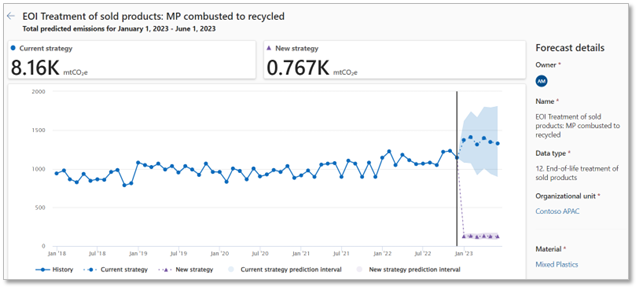Use AI to forecast sustainability strategies and outcomes
For organizations to remain competitive, they need intelligent tools that help predict and adapt to change. Data and AI solutions from Microsoft and partners, including Internet of Things (IoT), digital twins, predictive analytics, and high-performance compute, deliver intelligence to help you forecast potential outcomes and make informed strategic decisions.
Forecast and model sustainability outcomes help you predict and adapt to change while you continue to accelerate progress as follows:
Forecast and model climate and other environmental sustainability factors by using predictive models and AI-driven, what-if analysis scenarios. This approach can help you better understand and respond to changing variables.
Supply and demand forecasting can help you predict demand to inform inventory and logistics optimization strategies.
What-if analysis
To forecast the impact of several business practice changes on your organization's carbon emissions footprint, you can use the What-if analysis model. What-if analysis is a custom and intelligent AI model in Microsoft Sustainability Manager. It allows you to compare your current carbon emissions trends against the forecasted carbon emissions impact of changing variables in your business model. It helps you to create more informed carbon reduction strategies and accelerate your overall sustainability goals.
The What-if analysis model also simulates the impact of changes in product mix, planned production quantities, and improvements in short-term water consumption efficiencies for products.
Supported scenarios
What-if analysis supports the following scenarios. Each scenario has different levels of customization that allow you to tailor the forecast to your organization’s data and needs.
Scope 1 scenarios
The following are Scope 1 scenarios for what-if analysis:
Industrial process - Forecast the impact of switching the Industrial process type for a particular organizational unit or facility assigned to the organizational unit.
Mobile combustion - Forecast the impact of switching the on-road and off-road vehicles that your organization uses.
Stationary combustion - Forecast the impact of switching the fuel that a particular facility uses.
Scope 2: Purchased energy
All Scope 2 category forecast scenarios follow the same pattern, which is to switch from nonrenewable to renewable energy or vice versa.
Scope 3 scenarios
The following are Scope 3 scenarios, the numerals in parentheses indicating the scenario’s category number:
Purchased goods and services (1) and Capital goods (2) - Forecast the impact of switching the supplier from which you purchase goods and services.
Upstream transportation and distribution (4) and Downstream transportation and distribution (9) - Forecast the impact of switching the Transport mode that the organization uses and the corresponding Distance traveled and Goods quantity that the organization transports for Scope 3 categories 4 and 9.
Waste generated in operations (5) and End-of-life treatment of sold products (12) - Forecast the impact of changing the way that you dispose of a particular material.
Business travel (6) and Employee commuting (7) - Use the Business travel type and Employee commuting type fields to forecast the impact of changing the mode of transport that your organization members use for business travel or for employees who commute.
Supported time series forecasting models
Sustainability Manager supports (Seasonal) Auto Regressive Integrated Moving Average ((S)ARIMA) and Error Trend Seasonality (ETS) univariate time series forecasting models for generating forecasts on activity data. ETS models rely on the descriptions of trend and seasonality in the data, while ARIMA models describe the autocorrelations in the data. For more information, see Forecast business practice changes on your emissions with What-if analysis.
